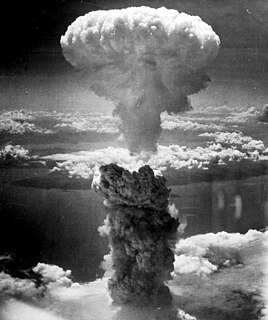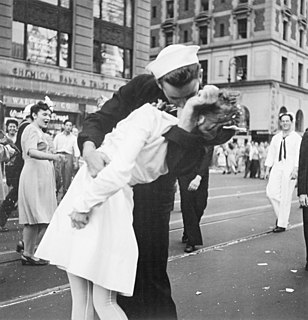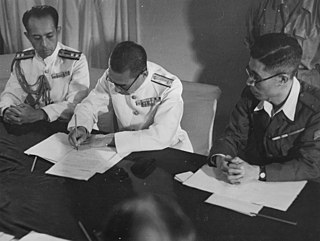
The Potsdam Declaration, or the Proclamation Defining Terms for Japanese Surrender, was a statement that called for the surrender of all Japanese armed forces during World War II. On July 26, 1945, United States President Harry S. Truman, United Kingdom Prime Minister Winston Churchill, and Chairman of China Chiang Kai-shek issued the document, which outlined the terms of surrender for the Empire of Japan, as agreed upon at the Potsdam Conference. The ultimatum stated that, if Japan did not surrender, it would face "prompt and utter destruction."

Hibakusha is a word of Japanese origin generally designating the people affected by the atomic bombings of Hiroshima and Nagasaki at the end of World War II.
World War II officially ended in Asia on September 2, 1945, with the surrender of Japan on the USS Missouri. Before that, the United States dropped two atomic bombs on Japan, and the Soviet Union declared war on Japan, causing Emperor Hirohito to announce the acceptance of the Potsdam Declaration on August 15, 1945, which would eventually lead to the surrender ceremony on September 2.

The surrender of the Empire of Japan in World War II was announced by Emperor Hirohito on 15 August and formally signed on 2 September 1945, bringing the war's hostilities to a close. By the end of July 1945, the Imperial Japanese Navy (IJN) had become incapable of conducting major operations and an Allied invasion of Japan was imminent. Together with Great Britain and China, the United States called for the unconditional surrender of the Japanese armed forces in the Potsdam Declaration on 26 July 1945—the alternative being "prompt and utter destruction". While publicly stating their intent to fight on to the bitter end, Japan's leaders were privately making entreaties to the publicly neutral Soviet Union to mediate peace on terms more favorable to the Japanese. While maintaining a sufficient level of diplomatic engagement with the Japanese to give them the impression they might be willing to mediate, the Soviets were covertly preparing to attack Japanese forces in Manchuria and Korea in fulfillment of promises they had secretly made to the United States and the United Kingdom at the Tehran and Yalta Conferences.

The then British colony of Malaya was gradually occupied by the Japanese between 8 December 1941 and the Allied surrender at Singapore on 16 February 1942. The Japanese remained in occupation until their surrender to the Allies in 1945. The first Japanese garrison in Malaya to lay down their arms was in Penang on 2 September 1945 aboard HMS Nelson.

WO1 Temenggong Datuk Kanang anak Langkau, SP, PGB, PGBK, PBS (Rt) was a Malaysian hero and soldier from the Iban Dayak community in Sarawak. He was in the Royal Ranger Regiment and Regimental Sergeant Major of 8 Renjer of the Malaysian Army with his tag number of 901378. He was awarded the Panglima Gagah Berani and Seri Pahlawan Gagah Perkasa medals from the Yang di-Pertuan Agong, Sultan Ahmad Shah on 3 June 1981. He is the sole recipient of both the Seri Pahlawan Gagah Perkasa and Pingat Gagah Berani, and was the last living recipient of the Seri Pahlawan Gagah Perkasa.

The British Military Administration (BMA) was the interim administrator of British Malaya from August 1945, the end of World War II, to the establishment of the Malayan Union in April 1946. The BMA was under the direct command of the Supreme Allied Commander South East Asia, Lord Louis Mountbatten. The administration had the dual function of maintaining basic subsistence during the period of reoccupation, and also of imposing the state structure upon which post-war imperial power would rest.

Operation Tiderace was the codename of the British plan to retake Singapore following the Japanese surrender in 1945. The liberation force was led by Lord Louis Mountbatten, Supreme Allied Commander of South East Asia Command. Tiderace was initiated in coordination with Operation Zipper, which involved the liberation of Malaya.

The United States detonated two atomic bombs over the Japanese cities of Hiroshima and Nagasaki on 6 and 9 August 1945, respectively. The two bombings killed between 129,000 and 226,000 people, most of whom were civilians, and remain the only use of nuclear weapons in armed conflict.

Substantial debate exists over the ethical, legal, and military aspects of the atomic bombings of Hiroshima and Nagasaki on 6 August and 9 August 1945 at the close of World War II (1939–45).
First Into Nagasaki: The Censored Eyewitness Dispatches on Post-Atomic Japan and Its Prisoners of War is a collection of reports by Chicago Daily News foreign correspondent George Weller. Originally written in 1945, but not approved for publication by Gen. Douglas MacArthur's military censors. The reports were collected and edited by the author's son Anthony Weller, and published for the first time in 2006.

Tsutomu Yamaguchi was a Japanese marine engineer and a survivor of both the Hiroshima and Nagasaki atomic bombings during World War II. Although at least 70 people are known to have been affected by both bombings, he is the only person to have been officially recognized by the government of Japan as surviving both explosions.
Charles Donald Albury was an American military aviator who participated in both atomic bombings of Hiroshima and Nagasaki. He piloted the United States Army Air Forces B-29 bomber known as the Bockscar during the mission that dropped the atomic bomb on Nagasaki on August 9, 1945. The bombing of Nagasaki killed an estimated 40,000 people instantly, and led to Japan's unconditional surrender on August 14, 1945, ending World War II.

The Battle of Kuala Lumpur was a battle between Japanese invasion forces and the British forces in Kuala Lumpur, in the then capital of the Federated Malay States, a British protectorate.

Kuching Heroes' Cemetery is a mausoleum located in Kuching, Sarawak, Malaysia. This cemetery is located at Jalan Taman Budaya.
Abdul Razak Abdul Hamid was a Malaysian academic and the only Malaysian survivor of the atomic bombing of Hiroshima on 6 August 1945. A prominent professor of the Japanese language, he was nicknamed "Razak-sensei" by friends and university students.

The following events occurred in August 1945:
Pengiran Muhammad Yusuf bin Abdul Rahim, pen name Yura Halim, was a Bruneian politician, civil servant, diplomat, and writer. He served as the Chief Minister of Brunei from 1967 to 1972. Halim wrote the lyrics for Brunei's national anthem, "Allah Peliharakan Sultan," in 1947. The song was adopted as the country's official national anthem in 1951, when it was still a British protectorate. Halim was longtime member of the Legislative Council of Brunei, serving on the council until his death in 2016.
This article lists important figures and events in the public affairs of British Malaya during the year 1941, together with births and deaths of prominent Malayans. The Japanese occupation of Malaya started in December 1941.

Operation Jurist referred to the British recapture of Penang following Japan's surrender in 1945. Jurist was launched as part of Operation Zipper, the overall British plan to liberate Malaya, including Singapore.














